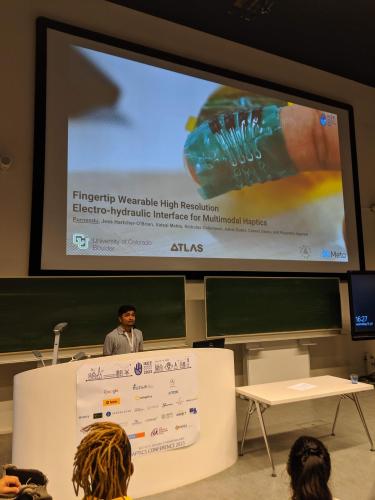ATLAS PhD Student Purnendu Presents at World Haptics Conference
ATLAS PhD student, Purnendu, presented research at the recent IEEE World Haptics Conference in Delft, Netherlands. Haptics is the science of touch, and this gathering is billed as “the premier international conference covering all aspects of haptics including the fundamental scientific findings, technological developments, algorithms and applications.”
Purnendu developed a wearable electrohydraulic fingertip interface during an internship at Meta’s Reality Labs, with the aim to improve how we perceive and use physical touch in virtual and augmented reality environments. Meta created Reality Labs to “bring together the brightest cross-disciplinary minds in one place to deliver our mission: build tools that help people feel connected, anytime, anywhere.”
[video:https://www.youtube.com/watch?v=sHb_Jq3AXyw]
We connected with Purnendu to hear more details on his haptics work and the conference. Take a look:

What was the initial inspiration behind this research?
The inspiration behind this research was to be able to augment human fingertips with a reliable sense of 'artificial touch' for the Metaverse (Augmented Reality/Virtual Reality Environments). Fingertips are one of the most sensitive regions of human skin and to be able to provide them with desirable tactile cues is an open problem. The most promising pathway is attaching a high density of multimodal actuators with capabilities to render a variety of forces (normal/shear) as well as vibrations.
This research leveraged my prior research on soft electrohydraulic actuators (happened at ATLAS) to develop a high resolution fingertip wearable multimodal haptic interface consisting of 16 individual actuators that can render high intensity pressure as well as a wide range of vibrations (within an area of 1 cm sq).
What was it like to work at Meta?
Meta Reality Labs is an amazing workplace. The realization that many of these research projects happening around me will form the foundation of the products that will come out in the next 5-10 years was thrilling. The depth as well as the breadth of the work happening there is mind boggling. But not only the research being performed was cutting edge, the team and people were really nice. Reality Labs is filled with folks who are super smart, skilled, motivated, and above all very kind. I had a great time working there.
How was your experience presenting at the conference?
IEEE World Haptics Conference is a premiere venue for the haptics community to present, discuss, and demonstrate research ideas and prototypes. My experience was beyond expectation. My presentation went really well; it was an instant hit and a lot of people reached out to me afterwards. The other presentations and demos were quite good (both from industry partners as well as academic labs). The highlight for me was to get to interact closely with the most senior researchers in the haptics community.
How has this research shaped your ongoing work as a PhD student in ATLAS?
This research has been along the lines of my PhD work at ATLAS and will be included in my dissertation. It had origins in the previous research I performed at ATLAS on soft electrohydraulic actuators. It helped me orient more towards my thesis work on steering soft materials with high-intensity electric fields.
Publication Details
Fingertip Wearable High-resolution Electrohydraulic Interface for Multimodal Haptics
Purnendu, Jess Hartcher‑O’Brien, Vatsal Mehta, Nicholas Colonnese, Aakar Gupta, Carson Bruns, Priyanshu Agarwal
Fingertips are one of the most sensitive regions of the human body and provide a means to dexterously interact with the physical world. To recreate this sense of physical touch in a virtual or augmented reality (VR/AR), high-resolution haptic interfaces that can render rich tactile information are needed. In this paper, we present a wearable electrohydraulic haptic interface that can produce high-fidelity multimodal haptic feedback at the fingertips. This novel hardware can generate high-intensity fine tactile pressure (up to 34 kPa) as well as a wide range of vibrations (up to 700 Hz) through 16 individually controlled electrohydraulic bubble actuators. To achieve such a high intensity multimodal haptic feedback at such a high density (16 bubbles/cm2) at the fingertip using an electrohydraulic haptic interface , we integrated a stretchable substrate with a novel dielectric film and developed a design architecture wherein the dielectric fluid is stored at the back of the fingertip. We physically characterize the static and dynamic behavior of the device. In addition, we conduct psychophysical characterization of the device through a set of user studies. This electrohydraulic interface demonstrates a new way to design and develop high- resolution multimodal haptic systems at the fingertips for AR/VR environments.


